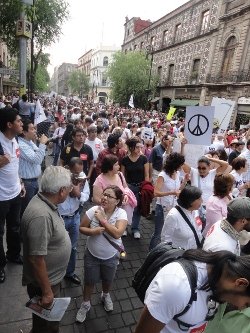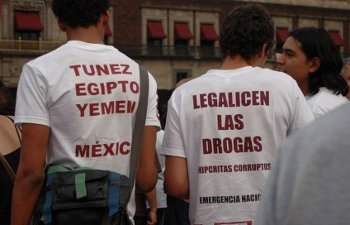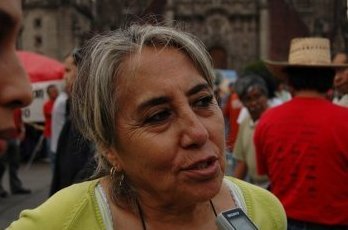


Why They Are Marching Against Drug War Violence
Mexican Citizens, In Their Own Words
By Erin Rosa
Special to The Narco News Bulletin
April 10, 2011
The mass marches that rocked Mexico last week made history, and in Mexico City attendees made their demands clear: no more violence, no more “war on drugs,” and no more militarization. With numbers reaching 20,000, the people marched from the city’s Bellas Artes palace to its central plaza in the zócalo. Like with any large group, there were different ideas and goals. Some talked about a vague notion of “peace,” which they thought would come with a better “strategy” for the drug war. Some thought the violence was due to Mexican President Felipe Calderón’s failings as a leader, and wanted another politician to take his place. Others said they would love to see Mexico start a revolution like Egypt. Despite the differences of opinion, after interviewing dozens of attendees, it was evident that everyone shared a tangible resentment towards the current Mexican government and its drug war.
 Mexico City marchers on their way to the zócalo. DR 2011 Sarahy Flores. |
On Facebook, the march was titled “40,000 pésames. Marcha por el cese de la violencia en nuestro país. (40,000 Condolences. The march to end the violence in our country),” and went viral, gaining hundreds of followers each hour. Others heard about the march by word of mouth. Fernando Morales Hernández, 16, decided to come to the march after he heard about it from a group of friends. He hadn’t heard of Javier Sicilia. “Mexico’s a beautiful country, but it’s a country with a lot of violence and problems,” he said, while holding a sign that read Ni uno más! (Not one more!) “I think that all Mexicans feel that the time for patience is already over.” Standing next to him, Alfredo Muñoz, 17, said he was fed up with seeing people his age killed in drug war violence. “I’m saying no more to this. It’s not important if young people are killed. When it comes to the issue of security with us, well, our system of security, the police, how are they making it better? Because many of them are corrupt.” Both Fernando and Alfredo are from Mexico City. When asked if they or family members had been personally affected by the violence they said “Fortunately, no.”
 Alfredo Muñoz and Fernando Morales Hernández DR 2011 Joshua Eichen. |
Even though many city dwellers are not directly affected by the violence, that doesn’t mean they aren’t concerned. Everyday, Mexico City residents watch and listen to the media as it reports on the grisly details of Calderón’s war—the parents whose children are murdered or disappeared, the public display of mutilated corpses—each story confirming that the bloodshed is getting worse, and worse, and worse. “I’m already sick of so many people being killed for no reason,” said Andrea Torres, who attended the march with her sister, Margaret. When asked why they came, Margaret said,“I’m here to support an idea that I have in common with all of the citizens. I’m a part of them. It’s that we’re tired of this silent war and not being able to do anything to help ourselves or the people that are dying.” When asked what was the solution to ending the violence, Andrea immediately responded “Education and legalization.” Why? “Education, so we aren’t making little narcos, and legalization to put an end to the quantity of drugs that are here. Maybe, like that, legalization can be a big step to ending all of the violence.”
 Santiago Mora Van and Toumani Camara show their T-shirts. DR 2011 Joshua Eichen. |
Francisco Diez paused when asked what egiptazo was. “It could be that…it is referring to us going out into the streets to take out the politicians, so that we find a way to change the policies of the government we’re against.” Diez said. “I would really like for the country and society to listen to what’s happening outside so they’ll support us.” Gabriella Torres, who was standing next to Diez, said “I don’t think we’re socially prepared for what that implies… We forget things. This is not the first time that we have seen violence.”
 Maria Teresa Tovar DR 2011 Joshua Eichen. |
These mobilizations come on the heels of the Mexican media’s controversial proposal to censor any negative news about the “war on drugs.” The unprecedented size and scope of this week’s protests against that war indicate that, like the militarized drug policy itself, the strategy is not achieving its intended result.
Lea Ud. el Artículo en Español
- The Fund for Authentic Journalism
For more Narco News, click here.




